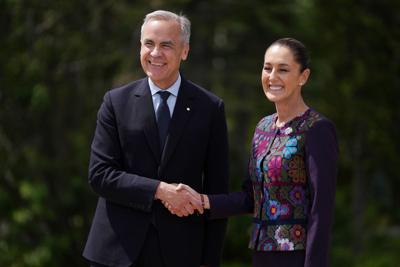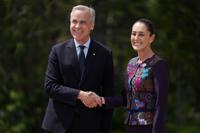In July, claims Canada and Mexico signed a trade deal meant to bypass U.S. tariffs spread online. There is no evidence such a deal exists. The source of the claim comes from a YouTube video that contains evidence it was created with the help of artificial intelligence, and many of the statistics and other information contained in the video is false or misleading.
THE CLAIM
"Canada and Mexico are partnering on a major infrastructure and trade initiative, called the Northern Corridor, aimed at avoiding U.S. tariffs and customs procedures to strengthen and grow our economic ties by $120 billion," reads a on the X platform, formerly Twitter.
Rumours of the supposed trade deal circulated just days before U.S. President Donald Trump increased tariffs on Canada to 35 per cent on Aug. 1.
Similar posts about the Northern Corridor initiative spread on , and along with the claim the U.S. economy could lose billions as a result of the deal.
RATING: No evidence
A keyword search of "Canada Mexico Northern Corridor" on Google brought up an from a publication focusing on supply chain issues.
The article's source was an 11-minute from the channel PPR Mundial posted July 18, with around 246,000 views.
According to the video, Canada and Mexico are planning to divert $120-billion worth of U.S. trade from American ports by delivering goods by rail and sea "without entering Texas ports."
A disclaimer that appears in the top left corner of the video and the description box notes it contains "altered or synthetic content," meaning audio or video was either altered or digitally generated. It's unclear if the script itself was written and researched by a real person or with artificial intelligence.
There are some signs the video's narrator could be AI. For example, the narrator keeps the same neutral tone through the video and does not take a breath or pause when it might be natural to do so, which results in the of separate words like "maple-lumber." When the narrator does pause between words, the is awkward and unnatural.
The video claims Canada's exports like steel, "maple," and lumber will head to the Gulf of Mexico via a "coastal shipping bridge." The between the two countries' largest ports, the Port of Vancouver and Port of Manzanillo, is around 4,917 kilometres by ship according to one estimate.
The B.C. government noted the logistical challenges of building a sea bridge when it researched the possibility of a between Vancouver Island and the Lower Mainland.
It noted Japan's Seikan Tunnel, which runs beneath the seabed, cost US$7 billion and took 25 years to complete, while a similar tunnel between Great Britain and the European mainland cost US$15 billion and took 11 years.
The video makes several factual errors, like mentioning goods can bypass Texas ports and Detroit "customs and logistics premiums," supposedly referring to tariffs that would have to be paid at any U.S. point of entry and not just Detroit.
It claims U.S. Customs and Border Protection data show goods from Canada and Mexico passing through U.S. ports totalled 756 billion tonnes in 2024.
The U.S. border protection doesn't track that data, however; the U.S. Department of Transportation does.
Their that between June 2024 and May 2025, North American freight data for U.S. exports to and imports from Canada and Mexico was around 404 million metric tonnes for Canada and 166 million for Mexico, which adds up to less than the tonnage claimed in the video. Historical data for 2024 doesn't show that amount either, and ��ɫtvcould not find where the video got the 756 billion number.
The video notes "Mexican battery modules" will travel by train to Prince Rupert, B.C. and then Ontario "without ever crossing the Canada-U.S. border." There is no rail route from Mexico to Canada that does not cross the U.S. border.
The supposed $120-billion loss the United States would suffer as a result of the trade deal represents about 4.5 per cent of Canada's GDP, the video claimed. This is false; the International Monetary Fund estimated at around US$2.241 trillion in 2024 and 4.5 per cent of that would be closer to US$100 billion.
The video is riddled with similar errors. It rarely cites its sources for statistics or information, and when it does the source is often different than claimed or the information is nonexistent.
PPR Mundial's YouTube channel description says it provides "in-depth coverage of major economic developments and geopolitical dynamics" and is based in the United States. It's unclear who is behind the channel or how they gather information for videos.
A keyword search found no ��ɫtv media reports or government press releases about the so-called "Northern Corridor." ��ɫtvreached out to Global Affairs Canada and will update this fact check if it receives a response.
SOURCES
Claim posted to July 24, 2025 (), July 26, 2025 (), July 27, 2025 () and July 29, 2025 ()
Kelly Geraldine Malone. Trump pushed tariffs on Canada to 35 per cent, but a CUSMA carveout creates a shield. ��ɫtvwebsite. Aug. 1, 2025 ()
Alex Lennane. Canada and Mexico get cosy with trade plan to bypass US. The Loadstar . July 21, 2025 ()
Even US STUNNED By Mexico Just Joined Canada’s $120 Billion Trade Corridor BYPASSES Trump’s Tariff! PPR Mundial, on . July 18, 2025 (, )
Vancouver to Manzanillo. Fluent Cargo . Accessed Aug. 1, 2025 ()
Potential Fixed Link to Vancouver Island. British Columbia government . June 25, 2024 ()
Mode, Port, and Commodity Dashboard. U.S. Department of Transportation Bureau of Transportation Statistics . Accessed July 31, 2025 ()
World Economic Outlook Database. International Monetary Fund . Accessed July 31, 2025 ()
ABOUT CANADIAN PRESS FACT CHECKS
You can find out more about ��ɫtvhere and about ��ɫtv Press Fact Checks here. To reach our fact-checking team with any tips, corrections or comments, please email us at cpfactcheck@thecanadianpress.com.











































